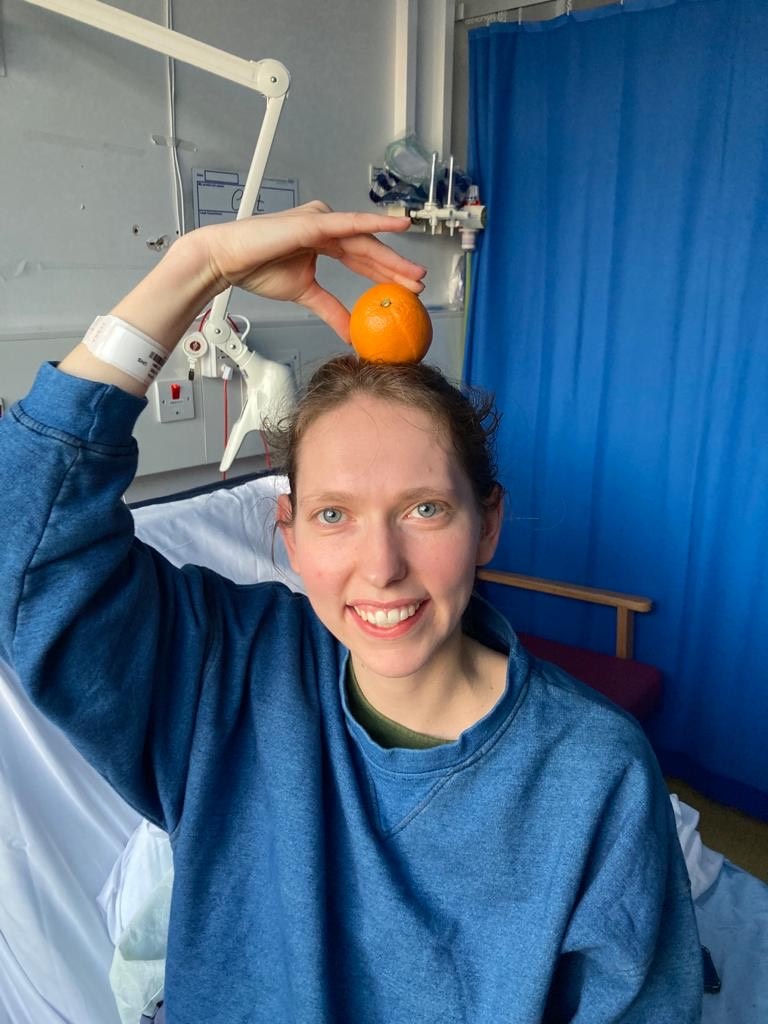A tumour the size of an orange
“I was on the M3 driving home for the weekend in March 2022 when all at once my right hand got pins and needles, my right arm became numb, and I felt the right side of my face droop down. I’m left-handed, and I’d noticed weakness in my left hand earlier too but put it down to not going to the gym.
I slowed down and thankfully quickly came across a petrol station where I could stop. I was feeling really sick by this point and had an intense pressure in my head. After trying to sit in a coffee shop, then trying to buy Paracetamol, I ended up going back to my car to lie down. Then I called NHS 111 who sent an ambulance.
I was taken to the nearest hospital for a CT scan. This showed a large mass the size of an orange in the centre of my brain. I was transferred to hospital in Winchester, which has a neurosurgery unit, later that evening. It was March 18 – I’ll never forget the date!.
10 days later I had an eight-hour operation to remove most of my tumour (which I have nicknamed “Cruella”). They couldn’t safely remove it all as it is in the central part of my brain so would affect my short-term memory centres.
Central neurocytoma – fast facts
- These tumours are rare and mostly non-cancerous.
- They differ from most brain and central nervous system tumours because they grow from neurons rather than glial cells.
- Neurons are a type of nerve cell that sends messages to and from the brain.
- They comprise less than 1% of brain tumours worldwide and mostly affect young adults.
- Symptoms can include blurred vision and increased intracranial pressure.

Looking back now there were loads of symptoms that I kept brushing off: the weakness in my left arm, a personality change and intense headaches. So my message to anyone reading this is: if you’re having weird headaches, go and get yourself checked out.
Catrin George-Carey
Treatment options
The histology showed I had an atypical central neurocytoma. This is benign but, unfortunately, the atypical part of it means that it is faster growing than typical ones.
The neurosurgery team who had performed my operation recommended radiotherapy. There was a delay in starting this as I was offered egg freezing for fertility preservation prior to starting – I now have 21 eggs in the freezer!
An alternative approach
By the time that was sorted, a routine scan pre-radiotherapy showed that the Cerebrospinal Fluid had built up into hydrocephalus (excess water on the brain) again. A permanent shunt was recommended. At this point my sister, who is a doctor, explained that she had been in touch with a neurosurgeon with experience in managing neurocytomas. He reviewed my case and recommended an alternative approach: repeat surgery to create a channel between the compartment which was getting blocked and the one next door. This would allow the fluid to drain and prevent (he hoped) further hydrocephalus.

What a decision to have to make! After a lot of thought, I decided to go with this second opinion. I had my second surgery in June 2022 and just over a year later, I am feeling well and living my life to the full! I have just finished my teaching degree and am about to start as a nursery teacher. I’m down to having scans every six months.
Looking back now there were loads of symptoms that I kept brushing off: the weakness in my left arm, a personality change and intense headaches. So my message to anyone reading this is: if you’re having weird headaches, go and get yourself checked out. It’s always better to be safe than sorry.
I also want to thank the amazing neurosurgery teams at Southampton University Hospital and Kings College London Hospital for everything that they did. And to the person from the call centre who sent the ambulance and the first paramedic who made the decision to get me checked over despite my attempts to reassure her that I was fine!
Learn more about brain tumour symptoms
The symptoms of a brain tumour can include headaches, changes in vision, tiredness, a loss of taste and smell, nausea and dizziness. If you are experiencing any of these, consider booking a checkup with your GP.
You can also learn more about brain tumour symptoms by clicking through to our dedicated site below:
